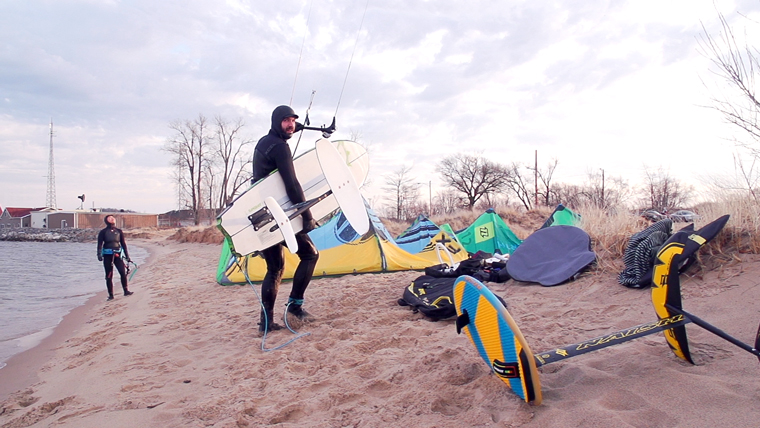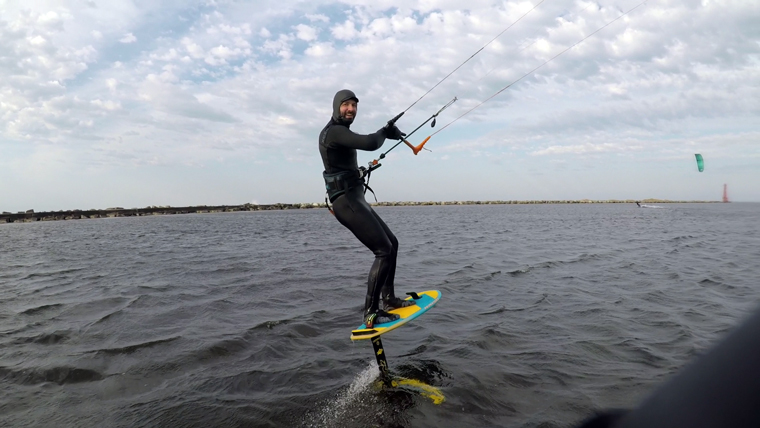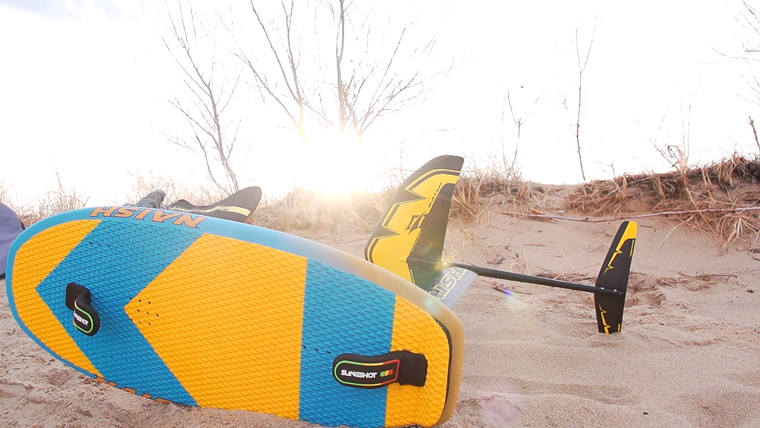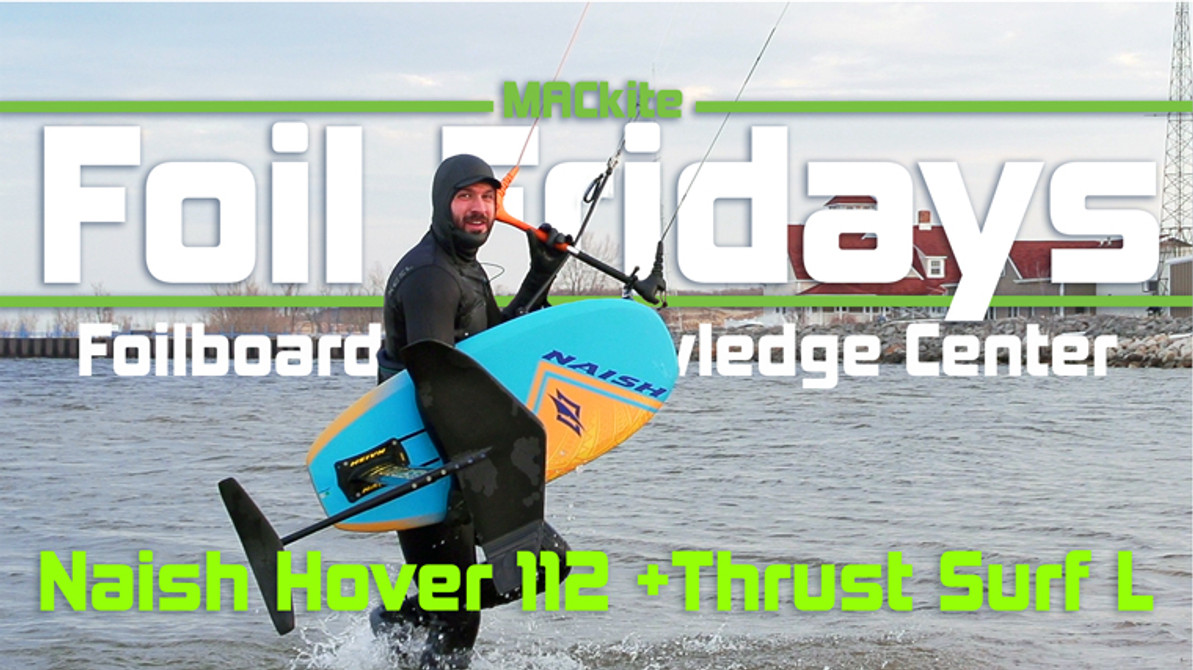Naish Hover 112 + Thrust Surf L Review
Working at MACkite has some unique benefits. Working with friends in an industry that we are passionate about makes most days feel less like “work”. The huge amount of demo gear available is also well appreciated by our staff. However, it is hard to monetize the value of our “Board Meetings”. Our "Board Meetings" are not the typical drudgery that is associated in most workplaces. Rather, it is a meeting of employees where we can go play and test gear during work hours.
Last week, we had one of our first spring sessions. We experienced smooth south winds hitting 18 knots. The air temperature was a welcome 45 degrees, rather than the freezing temps that our spring has offered so far. Hoping for some surf, I grabbed the Slingshot Sky Walker foil surfboard and the Cloud IX P27 surf foil. For kiteboarding, I grabbed theNaish Hover 112 foil board and the Naish Thrust Surf Large Foil. Being that the wind was a bit offshore, the waves had yet to arrive. The flat water that our protected spot presented was too enticing to refuse. With my trusty 5m Cabrinha Drifter, Naish 112, and Thrust Surf Large, I jogged down to the beach. There, I found our crew pumping up and happy for the first official board meeting of the year.

Cabrinha Drifter 5m kite
I have shouted the praises of the Drifter for a while so I will keep it short on that subject. The 5m is the perfect choice with a large surf wing for freeriding in winds 18-30mph. In this situation, I was on the low end of the Drifter's wind range. So, I flew the kite on 24m lines to maximize its power stroke when riding a smaller board such as the Naish 112.
Naish Hover 112 foil board
At only 3’10” (112cm), the Naish 112 is quite small when compared to other foil boards. Naish states,
“Highly compact with minimal volume, the Hover 112 takes full advantage of minimalist design. Intended for experienced-to-expert foilers, this petite board delivers superior control in tight turns for a dynamic and responsive riding experience. When riding strapless, another key advantage of its size is the ability to sink the board and position it on its edge for easier take-offs. Its precise, CNC cut, closed cell core is wrapped in lightweight, high-tensile fiberglass, which heightens durability without weighing it down. The dual track system allows riders to instantly adjust where the foil sits on the board, for a more customized riding experience. Experience the zen of being “one with your foil” with the Hover 112 foilboard.”
I agree with them in this assessment. Yet, “Experienced-to-expert foilers” is a bit vague for my liking. I would add that the rider weight, footstrap choice, and wing choice will expand this board’s usefulness to intermediate foilers. For example, a rider who is only 110 pounds could ride the Hover 112 board at an intermediate level without much trouble, especially if they are using a large wingset and a strap.

The largest challenge that this board presents to most riders will be board starting without “pearling”. Pearling is the submerging the nose of the board. Since the board is so small, the front of the board has a tendency to dive underwater during a board start. The addition of foot hooks or straps is the easiest method to counter this issue. It will allow you to pull the nose of the board upwards with your front foot as you also push your rear foot down on the tail of the board during your board start. Beginners may find that this creates a difficult situation as the wings begin to lift immediately. But, most riders with some foil history will find this easy to counter.
Foot hooks or straps work wonders for this but if you are a heavier rider this may not be enough. Using a larger wing in this case will allow you to generate more lift during a board start. Small wings will not create any lift during a board start because you have not created enough speed yet. But, larger wings will allow you to leverage their size for a more successful board start without pearling. This is also beneficial if you are foiling in a choppy or wavy environment. It will allow you to come on foil immediately rather than waiting to build board speed on the surface of the water.
Slingshot Half Straps
At roughly 190 lbs these days, I chose Slingshot Half Straps and the Naish Thrust Surf L foil. The half straps offer me the ease of board start that I like as well as the ability to boost a jump if I feel funky. They also offer the freedom to move my feet freely as I foil and transition.

Naish Thrust Surf L Foil
Like most surf foils and wings, the Naish Thrust Surf L is under-utilized in the kiteboarding community. We have known for years that most riders will benefit from a larger wingset when kite foiling but it is just starting to take root in the industry. As a result, Naish does not have much to say about it with regard to kiteboarding. Most kiteboarders foiling today are in the beginner to intermediate category, primarily using foiling for light winds or underpowered freeriding. The combo of low speed lift, progression, stability, and usability make these the best choice for addressing those rider's needs.Naish Thrust Surf compared to other Surf Foils When compared to other options for surf foils, the Thrust surf is a great choice. It is has multiple wing and mast options, a durable yet lightweight alloy construction, and an adjustable rear wing pitch. All for a price that doesn’t need a mortgage. The Naish Thrust Surf is praised by surf foilers because of its maneuverability. This is due to its kinked wingtips which serve as a pseudo anhedral/winglet while also reducing the chance of your wingtip surfacing.
Compared to the Cloud IX P27 & Gofoil Iwa 170 Foil
This translates to kiting well because it provides a good amount of lift without sacrificing too much playfulness. Comparing to the Cloud IX P27 that I also rode during this session, the Thrust Surf L has a raw, nimble feel that more aggressive riders will appreciate.
Another popular comparison for the Cloud IX P27 hydrofoil is the Gofoil Iwa 170 foil. Both are popular choices for legendary surfers who are adapting to the sport. Both the P27 and Iwa provide a silky smooth ride, excellent glide, and pump-ability that will have you jumping from wave to wave in no time. The board connection is the largest point of differences in these two foils. Gofoil uses a proprietary “Gofoil Tuttle” connection that will require an adapter to fit the industry standard “plate mount” where Cloud IX uses a plate system that will adapt to most boards on the market. Although the Cloud foil is an alloy/carbon construction, it is remarkably similar in weight to the Gofoil. Especially if you add the weight of the adapter if you choose to use one. Another point of difference is that Gofoil only offers the 24” mast. For riding choppy swell, kiteboarding
Why I chose the 70cm Mast
For this session I chose the 70cm mast which allowed me to foil without worry in our shallow flat water spot. I also prefer a 70cm mast on this foil when surfing as it allows for more forgiveness and pumping ability. (Double bonus since I do not need to change masts from session to session.) For kiteboarding, it enables you to chase waves closer to shore. With the great stability that these wings offer, it sacrifices nothing in performance from my perspective. I have also had a lot of fun with this setup using the Naish Thrust Windsurf foil. So for you windsurfers, look at this foil to do double duty with the addition of a short fuselage for kiteboarding.

Tucker Vantol
MACkite's resident surf and "Foilboarding junkie." You can either catch him on the phones or on the water at dawn testing new gear. he is proficient at a myriad of sports, a shaper and passionate about getting his water time. When he discover kiteboarding it took over as his predominate sport. The same could be said about hydrofoiling.
Recent Posts
-
Kiteboarding | Crafting the Harlem Force Kite with Sustainability and Performance
Unparalleled Performance Meets Unmatched Sustainability The kiteboarding industry is on …24th Apr 2024 -
Duotone Ventis 2025 | What's New?
If you're familiar with Duotone's Ventis, you know its specialty is freeriding in light wind …23rd Apr 2024 -
Duotone Ventis D/LAB 2025 Overview
If you ride in an area with multiple light wind days and need a wing that'll let you get o …23rd Apr 2024




